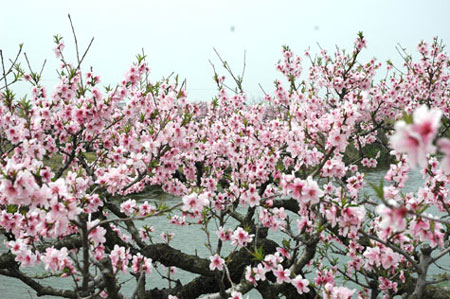
It's springtime again, the season of flowers. Even if you're not the sort of person who enjoys floral extravaganzas, a walk among the flourishing blossom, savoring fragrant hyacinths, coveting kaleidoscopes of orchids and stroking soft rosemaries, can be an extraordinarily pleasant experience.
As the biggest base for peach production in eastern China, Nanhui District boasts nearly 6,667 hectares of peach groves. The district is about to launch this year's Shanghai Peach Blossom Festival which runs late March to early April.
The festival is scheduled to kick off on March 25 and end on April 13, but mother nature will play a key role in determining when the star attractions will appear.
"This year's winter was colder than previous years and this could delay the blooming time," said Xia Longgen, a researcher from the district's Agricultural Commission. "But as the temperature gets higher, the flowers will bloom overnight. It's just a matter of time."
The flower fete began in 1991 and this year will have its 18th birthday. Over the years, the festival has become a must-see item on city residents' springtime travel plans.
Last year, the peach blossom gala attracted more than 500,000 visitors from the city as well as throughout the Yangtze River Delta region. The number is estimated to exceed 600,000 this year.
In Chinese culture, peach blossom, with its dainty, pink petals, symbolizes life, growth and prosperity. Regarded as the most auspicious plant, the flower is also said to be a blessing to protect people from evil spirits. But what makes the peach blossom win the hearts of so many Chinese is its metaphor for romance in Chinese literature, which suggests peach blossom can bring people good luck in love. Many folk stories say that those who meet his or her loved one under a blossoming peach tree will enjoy a lucky relationship.
Nanhui has four big peach villages in Datuan, Laogang (Binhai Resort), Xinchang and Huinan towns. These are key scenic spots for city dwellers to appreciate the rosy landscape of peach blossom and celebrate the return of spring. The flower carnival is just part of the fun during the festival.
Winter-weary visitors should find consolation strolling on the quiet countryside paths lined with willowy bamboo or taking a slow boat ride along the interlaced canals to have a panorama of the towns and villages by the water.
Tourists can also venture into the homes of hospitable farmers and indulge in the local delicacies, while enjoying traditional folk shows, such as paper-cutting, lion-dancing, stilt-walking and many others, performed by local folk artists.
In addition, an exhibition of new species of tulip in the district's Shanghai Flowers Port will become another attraction for visitors.
Bulb growers will be showing off millions of tulips beginning March 28. The 99.75-hectare flower port has a 360,000-square-meter greenhouse, the biggest in China, and a 3,500-square-meter research and development center for new floral types. It produces nearly 100 million flower seedlings annually.
What will amaze visitors most will be the 280,000-square-meter Dutch Tulip Park, a Chinese version of Holland's Keukenhof, featuring Dutch-style architecture with windmills and young girls in traditional clothing walking around. In order to facilitate transport between the flower extravaganzas and the city's downtown area, the Shanghai Tourist Transport Center will provide daily shuttle buses during the festival.
Besides walking through the seas of flowers, Nanhui also boasts dozens of tourist attractions from cultural relics, natural scenery to modern resorts, such as 1,000-year-old Xinchang Old Town where movie director Ang Lee shot his "Lust, Caution," Yangshan Deep-Water Port, Shanghai Wild Animals Park, Binhai Forest Park, 36-hole Binhai Golf Course and many others.
(Shanghai Daily March 22, 2008)